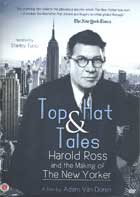
Top Hat & Tales: Harold Ross and the Making of The New Yorker 2001
Distributed by First Run Features, 630 Ninth Avenue, Suite 1213, New York, NY 10036; 212-243-0600
Produced by Adam Van Doren
Directed by Adam Van Doren
DVD, color and b&w, 47 min.
Sr. High - General Adult
Journalism, Writing
Date Entered: 08/21/2014
Reviewed by Mary Northrup, Metropolitan Community College-Maple Woods, Kansas City, MissouriFor fans of The New Yorker magazine, this documentary should prove enticing. It relates how Harold Ross started the magazine in 1925 and how he surrounded himself with the people who made it what it was and set it on its long publishing life.
Numerous talking heads comment on aspects of the magazine, including writers, artists, the current editor, Ross’s biographer, a former cartoon editor, and journalists, some of whom worked for The New Yorker and some who have not. These are interspersed with black and white stills and film (and color, for later years) which reflects the times. Also included are lots of shots of The New Yorker pages. The life of Harold Ross before The New Yorker is briefly covered, but the bulk of the film focuses on the history of the magazine from 1925 until 1951, when Ross died. It does a good job of showing the intent of Ross to publish a local, weekly, witty magazine, and stressing the importance of humor in the writing and the art. Also coming through clearly in the film are his attitudes toward money, his staff, minorities, and women, which provide a fuller picture as those attitudes were not always exemplary.
The visuals provide an excellent look at the 1920s, 30s, and 40s in New York. The background period music contributes to the mood of the film. For these reasons, students of history, especially these time periods, may also be interested in the film. But most especially, students interested in journalism or publishing, as well as the general public who are New Yorker readers, will be the prime audiences. This documentary would be most appropriate for college libraries and public libraries where there is interest.